As has been pointed out before in these pages, Japanese ramen has become the dominant noodle for specialist noodle stores around Taipei, to the considerable detriment of the many other types of noodles available. So it is with delight that we welcome the recent opening of Inaka Udon (稻禾烏龍麵) just a stone’s throw from the Zhongshan MRT Station, with another outlet to open next month in Eslite’s Xinyi flagship store.
Inaka Udon specializes in dishes using the udon noodle, a fat wheat flour noodle that when prepared properly, should provide a sumptuous body along with just a hint of resistance to the bite. The basic udon dish, served with a mild stock made from dashi and flavored with soy, bonito or other ingredients, is deceptively simple, and the number of places offering utterly indifferent udon are beyond count.
Inaka Udon, which targets the budget diner, does a pretty good job with both noodles and broth. As the restaurant’s name suggests, it specializes in udon and the noodles themselves are made on the premises.
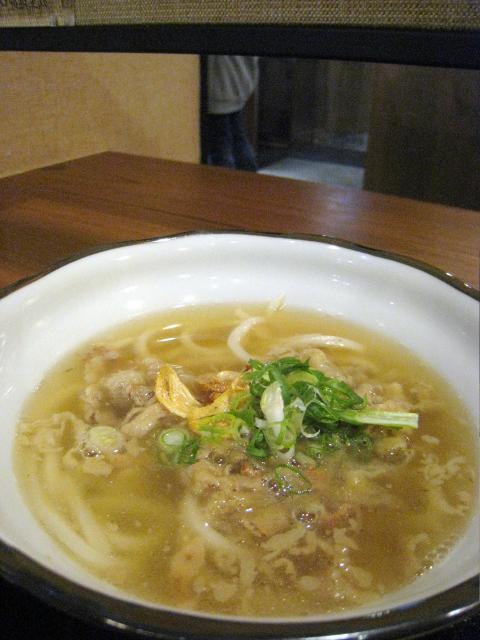
Photo: Ian Bartholomew, Taipei Times
It can be a little confusing when you first walk into Inaka, since there seem to be no service staff and the buffet counter requires some navigating. Instructions are posted, but it is slightly off putting to have to read a how-to manual when all you want is a meal. It is recommended that you first select from the deep fry counter, then select from the cold side dish counter, then finally make you order of a bowl of udon noodles at the noodle counter. The whole thing is then tallied up, you pay your bill, you then hit the condiments counter for a selection of ingredients to enhance your dish, then sit down to enjoy a light, balanced and flavorful meal.
The highlight of the deep fry counter is the fried chicken, which is crisp, flavorful and at just NT$60 a skewer, remarkably inexpensive. Shrimp tempura at NT$80 is a little on the pricy side, but then shrimp always seems to command a premium regardless of how unremarkable it actually tastes.
Deep fried onion tempura is also available for NT$50, and it makes a splendid textural contrast with the noodles.
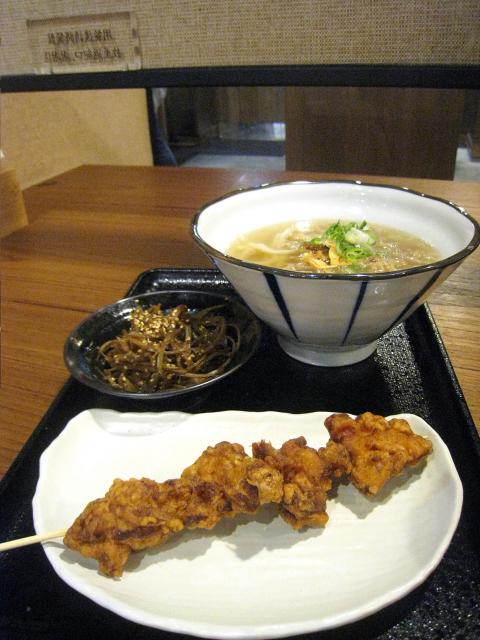
Photo: Ian Bartholomew, Taipei Times
At the cold counter there is cucumber with miso dressing (NT$50), burdock salad (NT$40), tomato with plum dressing (NT$60, highly recommended) and a Japanese style salad (NT$50). All are well prepared and pack bundles of flavor. The only complaint is that the deep fried food can be a little cold and limp if you happen to catch it during a quiet period.
The establishment’s signature dish is the garlic beef udon (蒜香牛丼, NT$160). It takes seconds to prepare at the noodle counter, as all the ingredients are pre-prepared. The service is quick and efficient, but watching the staffer ladle out the garlic beef over the quickly blanched noodles had a slightly institutional feel, tainting the sophisticated atmosphere that the restaurant has been remarkably successful in creating through clever choice of furnishing and elegant crockery.
That said, the flavoring of the garlic beef broth is quite subtle and doesn’t overburden either taste buds or digestive system, and provides a lovely complement to the noodles.
The kimchi udon (泡菜烏龍麵, NT$150) and udon with curry sauce (咖喱拌麵, NT$140), with hints of chili heat, are an excellent choice for the adventurous diner. To taste the udon at its most unadorned, try the noodles with a simple soup dipping sauce (沾麵, NT$110). Freshly made udon makes a huge difference, allowing Inaka to compete with more upscale Japanese restaurants, if only in terms of its noodles.
There is a bell at the door that customers can strike if they have enjoyed their meal. On the occasions I have visited, the cheerful chime of a satisfied diner could be heard quite regularly.
To celebrate its opening, discounts of NT$10 and NT$20 are being offered on dishes, making a meal at Inaka an excellent deal. The clever way that sophisticated food is served in a stylish environment for a good price should ensure that Inaka will survive its transition to regular pricing once its operations are fully underway.
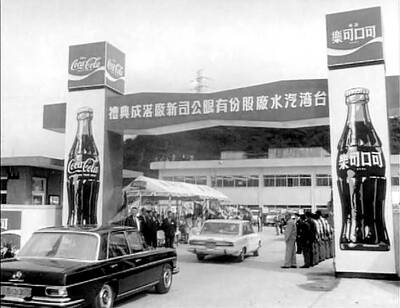
July 28 to Aug. 3 Former president Chiang Kai-shek (蔣介石) reportedly maintained a simple diet and preferred to drink warm water — but one indulgence he enjoyed was a banned drink: Coca-Cola. Although a Coca-Cola plant was built in Taiwan in 1957, It was only allowed to sell to the US military and other American agencies. However, Chiang’s aides recall procuring the soft drink at US military exchange stores, and there’s also records of the Presidential Office ordering in bulk from Hong Kong. By the 1960s, it wasn’t difficult for those with means or connections to obtain Coca-Cola from the
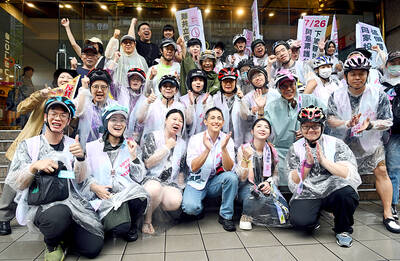
Taiwan is today going to participate in a world-first experiment in democracy. Twenty-four Chinese Nationalist Party (KMT) lawmakers will face a recall vote, with the results determining if they keep their jobs. Some recalls look safe for the incumbents, other lawmakers appear heading for a fall and many could go either way. Predictions on the outcome vary widely, which is unsurprising — this is the first time worldwide a mass recall has ever been attempted at the national level. Even meteorologists are unclear what will happen. As this paper reported, the interactions between tropical storms Francisco and Com-May could lead to

A couple of weeks ago the parties aligned with the People’s Republic of China (PRC), the Chinese Nationalist Party (KMT) and the Taiwan People’s Party (TPP), voted in the legislature to eliminate the subsidy that enables Taiwan Power Co (Taipower) to keep up with its burgeoning debt, and instead pay for universal cash handouts worth NT$10,000. The subsidy would have been NT$100 billion, while the cash handout had a budget of NT$235 billion. The bill mandates that the cash payments must be completed by Oct. 31 of this year. The changes were part of the overall NT$545 billion budget approved
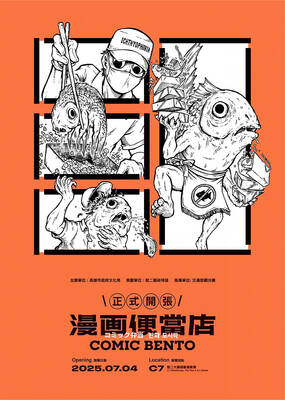
It looks like a restaurant — but it’s food for the mind. Kaohsiung’s Pier-2 Art Center is currently hosting Comic Bento (漫畫便當店), an immersive and quirky exhibition that spotlights Taiwanese comic and animation artists. The entire show is designed like a playful bento shop, where books, plushies and installations are laid out like food offerings — with a much deeper cultural bite. Visitors first enter what looks like a self-service restaurant. Comics, toys and merchandise are displayed buffet-style in trays typically used for lunch servings. Posters on the walls present each comic as a nutritional label for the stories and an ingredient